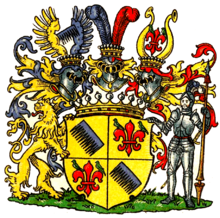Anrep (noble family)
Anrep is the name of a Baltic German aristocratic family that originally came from Westphalia and later spread to the rulership of Sweden , Poland , Denmark and Russia .
history
The family probably comes from Anreppen , a district of Delbrück in North Rhine-Westphalia since 1975 , where there were several prehistoric noble families of the same name, but no connection has been documented to any of them. The place still has a coat of arms identical to the ancestral coat of arms of the Anrep.
In Livonia , the family appeared for the first time in a document from 1470–1501 with Goswin Anrep , who held a number of fiefs in Helmetschen from the German Order . The line of stem of the sex begins with him .
In 1635, the Swedish lieutenant Gustaf Anrep was given the Swedish nobility naturalization and was introduced to the nobility class of the Swedish knighthood .
The Livonian lines were registered with the Livonian knighthood in 1742 , Friedrich Wilhelm von Anrep because of his estate Tecknal in 1745 with the Estonian knighthood .
1853, the Russian was Lieutenant General and Adjutant of the Emperor Josef Karl von Anrep in the Russian count conditions raised . Emperor Nicholas I approved a coats of arms and name association with that of his wife, Countess Cäcilie Philippine von Elmpt († 1892), the last of her sex. The Counts Anrep-Elmpt ( Russian Анреп-Эльмпт ) took over the Elmpt's successor in Burgau , but already died out in the male line in 1888 in the next generation. The daughter Cäcilie von Anrep-Elmpt (* 1847) married Count Keyserlingk . Their daughter Margarete Countess von Keyserlingk (* 1876) became Burgau's heir.
coat of arms
The coat of arms of the Livonian lines shows in gold a slanting black comb with the prongs pointing downwards. On the helmet with black and gold covers, the crest between open, right golden and left black flight . (The combined coat of arms of the Russian Counts of Anrep-Elmpt, however, depicts the crest in blue, in the same color as the Swedish line.)
The coat of arms of the Swedish lines shows a horizontal blue comb in gold with the prongs pointing upwards. On the helmet with blue-gold covers, the crest between open, right gold and left blue flight.
The Count's coat of arms Anrep-Elmpt (1853) shows in the quartered shield in fields 1 and 4 in gold, inside a slanted blue comb with 13 prongs pointing upwards (Anrep); in fields 2 and 3 a red lily in gold ; on each of the curved leaves there is a green, right- sighted parakeet with a gold collar (Elmpt). The count's crown rests on the shield . Three helmets over the crown, each crowned by a gold count's crown. Above the right helmet is an open eagle flight , the right wing of which is golden, the left blue, with a blue crest (anrep) floating in between. The helmet on the left has two golden buffalo horns , with the shield of fields 2 and 3 in between. Two ostrich feathers protrude from the middle helmet , the right one is blue, the left one is red. The covers are blue-gold on the right, red-gold on the left. Shield holder : on the right an upright, right-turning, double-tailed, golden lion , on the left a facing man in silver armor with two left-facing blue ostrich feathers on his helmet.
Relatives

- Reinhold Anrep († 1602), Estonian district administrator and Swedish field marshal
- Reinhold von Anrep (1760–1807), Russian lieutenant general
- Reinhold von Anrep-Elmpt (1834–1888), German-Baltic officer and explorer
- Count Joseph Karl Anrep-Elmpt (1796–1860), Russian lieutenant general
- Gabriel Anrep (1821–1907), Swedish genealogist
- Vassili von Anrep (1852–1927), German-Baltic physician at the Julius Maximilians University of Würzburg
- Boris Anrep (1883–1969), German-Baltic mosaic artist, active in London
- Gleb Anrep (1890–1955), German-Russian physician and university professor
literature
- Gabriel Anrep : Svenska Adelns Ättar-Taflor. Norstedt & Söner, Stockholm 1858, pp. 70-74 .
- Danmarks nobility Aarbog. Volume 1, 1884, p. 30
- Sveriges ridderskaps och adels calendar. 1923, pp. 30-32
- Astaf von Transehe-Roseneck (edit.): Genealogical manual of the Livonian knighthood . Part 1, 1: Livonia, vol .: 1, Görlitz, 1929 pp. 1–15
- Otto Magnus von Stackelberg (edit.): Genealogical manual of the Estonian knighthood . Part 2, 1.2: Estonia, Görlitz, 1930 pp. 644–646
- Robert Engelhardt: On the history of the Anreps on thrush . In: Baltische Familiengeschichtliche Mitteilungen, 1932, pp. 56–57
- Nicolai von Essen (edit.): Genealogical manual of the Oeselschen knighthood . Tartu 1935, p. 652
- Genealogical manual of the noble houses B 6, 1964, pp. 1–30, volume 32 of the complete series. CA Starke Verlag , Limburg (Lahn).
- Genealogisches Handbuch des Adels , Adelslexikon Volume I, p. 97, Volume 53 of the complete series, 1972; Volume XVII, p. 20, Volume 144 of the complete series, 2008 (supplements). CA Starke Verlag, Limburg (Lahn).
- Fanny von Anrep: Letters from a Livonian woman from the years 1873-1909 ; edited by Gertrud Westermann . Lüneburg: Carl-Schirren-Ges. 1990. ISBN 3-923149-18-2
Individual evidence
- ^ Schlossarchiv.de: Castle and Manor Burgau.
- ^ Genealogisches Handbuch des Adels, Adelslexikon Volume I, Volume 53 of the complete series, 1972 p. 97.
- ^ Herrmann Wagener: "New Conversations-Lexicon: State and Society Lexicon", Volume 2, Verlag F. Heinicke, Berlin 1859, p. 335 f. + Description addition.

